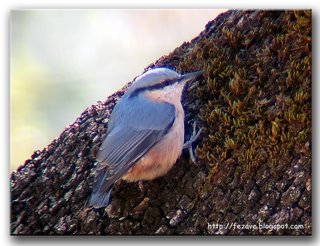ARROYO FUENTE DEL REY (ARACENA-HUELVA)

Crónica 17/09/2006
Este fin de semana he estado en una casa rural en el Castillo de las Guardas (Sevilla), el sábado por la mañana me acerqué al Arroyo de Marimateos (Aracena-Huelva) y el domingo estuve en el Arroyo de Fuente del Rey (Aracena-Huelva). Mi objetivo era ver al Pico Menor (Dendrocopos minor), pero no tuve suerte. Me sorprendió el paisaje del arroyo de Fuente del Rey, al principio aparecen huertas y granjas con casas rurales de piedra, campos cultivados y ganado, y conforme avanzo paralelo al arroyo la vegetación se hace más abundante, ofreciendo un espectáculo de naturaleza relajante y a la vez sobrecogedor. Bajé hasta el arroyo y estaba totalmente rodeado de vegetación, estaba extasiado, sólo se escuchaba el ruido del arroyo y el canto de los pájaros, estaba tan relajado que casi no le dedicaba mucho tiempo a la fotografía. Observé acercarse silenciosamente un Chochín, me sorprendió un grupo de Mitos que se posaron a un par de metros de mí y así pasé parte de la mañana disfrutando de tan maravilloso espectáculo. Pude ver las siguientes especies:
This weekend I have been in a rural house in the Castillo de las Guardas (Seville), on Saturday morning I approached Marimateos's Creek (Aracena-Huelva) and Sunday was in the Creek of Fuente del Rey (Aracena-Huelva). My aim was to see to the Lesser Spotted Woodpecker (Dendrocopos minor), but I was not lucky. I surprised the landscape of the creek of Fuente del Rey, initially gardens and farms appear with rural houses of stone, fields cultivated and cattle, and similar tender parallel to the creek the vegetation becomes more abundant, offering a spectacle of relaxing nature and simultaneously impressively. I went down up to the creek and it was totally surrounded with vegetation, was captivated, only there was listened the noise of the creek and the singing of the birds, was so relaxed that almost I was not dedicating him a lot of time to the photography. I observed a Wren to approach silently, I surprised a group of Long-tailed Tits that settled to a couple of meters of me and this way I spent part of the morning enjoying so wonderful spectacle. I could see the following kinds:
Buitre Leonado Gyps fulvus Griffon Vulture
Aguililla Calzada Hieraetus pennatus Booted Eagle
Abubilla Upupa epops Hoopoe
Cogujada Común Galerida cristata Crested Lark
Golondrina Dáurica Hirundo daurica Red-rumped Swallow
Lavandera Cascadeña Motacilla cinerea Grey Wagtail
Chochín Troglodytes troglodytes Wren
Petirrojo Erithacus rubecula Robin
Ruiseñor Común Luscinia megarhynchos Rufous Nightingale
Tarabilla Común Saxicola torquata Common Stonechat
Mirlo Común Turdus merula Blackbird
Zarcero Común Hippolais polyglotta Melodious Warbler
Curruca Carrasqueña Sylvia cantillans Subalpine Warbler
Curruca Cabecinegra Sylvia melanocephala Sardinian Warbler
Curruca Mirlona Sylvia hortensis Orphean Warbler
Mosquitero Papialbo Phylloscopus bonelli Western Bonelli's Warbler
Mosquitero Común Phylloscopus collybita Common Chiffchaff
Mosquitero Musical Phylloscopus trochilus Willow Warbler
Papamoscas Gris Muscicapa striata Spotted Flycatcher
Mito Aegithalus caudatus Long-tailed Tit
Herrerillo Capuchino Parus cristatus Crested Tit
Herrerillo Común Parus caeruleus Blue Tit
Carbonero Común Parus major Great Tit
Trepador Azul Sitta europaea European Nuthatch
Agateador Común Certhia brachydactyla Short-toed Treecreeper
Arrendajo Garrulus glandarius Eurasian Jay
Cuervo Corvus corax Common Raven
Estornino Negro Sturnus unicolor Spotless Starling
Pinzón Vulgar Fringilla coelebs Common Chaffinch
Verderón Común Carduelis chloris Greenfinch
Jilguero Carduelis carduelis Goldfinch
Escribano Soteño Emberiza cirlus Cirl Bunting
Triguero Miliaria calandra Corn Bunting
Eso es todo. No he visto mucha cantidad de pájaros pero he disfrutado conociendo estos dos lugares nuevos para mí.
It is quite. I have not seen quantity of birds great but I have enjoyed knowing these two new places for me.
Foto: Trepador Azul (Sitta europaea)
Más fotos en: http://www.galeriade.com/fezave
Photo: European Nuthatch (Sitta europaea)
More photos in: http://www.galeriade.com/fezave







1 Comments:
Pico Menor!!!!
Anda que no es difícil ni nada, yo tuve la suerte de verlo en el pirineo cerca de Broto casí a los pies de Ordesa, todo una maravilla. Espero que la próxima vez tengas mucha más suerte.
Saludos,
Brookei
Publicar un comentario
<< Home